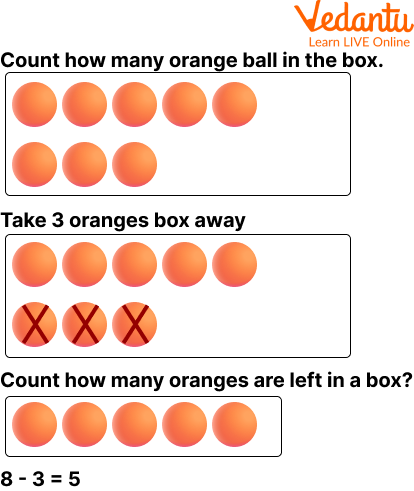




Introduction to Subtraction Methods
As we all know, subtraction is a mathematical operation that takes part away from another value. Here in this lesson, we will understand subtraction, types of subtraction models, subtraction by crossing out, and some solved examples on add and subtract for class 2. Subtraction is the series of taking away a number from another. It is a primary operation denoted by a subtraction symbol (-) and is the method of calculating the difference between two numbers. So, let’s further learn about it in this article by understanding more about it and solving some questions.
What is Subtraction?
Subtraction is used to find the difference between numbers. When we have a group of objects, and you take away a few objects, the group becomes smaller. Subtraction methods are many ways numbers can be subtracted. The method will depend on the problem. We will be going to study in the future.
E.g. you bought 10 balls for your friend, and your friend takes 7 balls. This can be written as 10-7=3 and is read as “ ten minus seven equals three.” Here, we performed the subtraction operation on two numbers 10 and 7 to get the difference of 3.

Subtraction
Types of Subtraction Models
Teaching all four models of subtraction-take-away, comparison, completion and whole/part/part--can better train elementary school children to think abstractly and relate their math knowledge to the real world.
Take-Away Model
The takeaway model is the most commonly taught subtraction model. It teaches children that taking away some objects from a set results in fewer objects in the set. To teach children the take-away model, set a particular number (e.g. 8) of objects (apples, oranges, blocks, etc.) in front of them and ask them to take away a small number (e.g. 3) of objects. Then ask them how many objects remain. In some exercises, children learn that subtracting objects from a set results in a smaller number (e.g. 8 -3 = 5 ).

Take away model
Completion Subtraction
The completion subtraction model makes children understand algebra lessons since it forces children to manipulate variables in a basic subtraction equation. For example, a completion subtraction is “7 +? = 10.” Use the same blocks or orange balls you used in the takeaway model to teach children this concept. So here, if 3 balls are added to the 7 orange balls, then it will become 10.
So to get this three, we need to do the subtraction, i.e. 10 - 7 = 3.
Comparison Model
The comparison model of subtraction, which involves comparing two different numbers, is a little more challenging to visualise than the takeaway model. An example of comparison subtraction is “If Ram is 26 and Shyam is 36, how many years older is Shyan than Ram?” Since by using these types of problems, children understand concepts easily.
Whole/Part Model
The part model of subtraction involves categories of objects that need to be subcategorised: “I have five mangoes for sale. Three are green mangoes. How many aren’t green apples?”. In this way, we can categorise the objects and use this model.
How to Solve Subtraction by Crossing Out?
Crossing out is a memory game that models subtraction situations in a frame using crossing out (strike-through) and the matching equation without the difference. Subtract models subtraction situations in a frame using crossing out (strike-through) and the matching difference.

Subtraction by Crossing Out
Solved Examples on Add and Subtract for Class 2
Q.1. Find out the number of apples in the box. If the box contains 10 apples and 6 are removed, how many apples are left in the box?
Solution: Total number of apples in the box is 10.
Out of which, 6 apples are removed.
The number of apples left is given by,
10 -6 =4
Thus the number of apples left in the box is 4.
Q2. Newton catches 25 fish in a lake. He puts 13 fish back. How many fishes does he have now?
Solution: No. of fish caught are 25 fish.
No. of fish that were put back are 13 fish.
Fishes left are given by,
25 - 13 =12.
Thus the number of fish left is 12.
Q3. There are 39 birds in a tree. A loud noise scares 16 birds away, what number of birds are left in the tree?
Solution: There are 39 birds in a tree.
Out of which, 16 birds away from a tree.
Left birds are given by,
39 - 16 =23.
Thus the number of birds left in the tree is 23.
Practice Questions
Q.1. Mark had 10 blue marbles. Jim had 6 red marbles. What number of marbles do they have in total?
Ans: 16.
Q.2. There are 6 blue Marlins and 2 snappers in the pond. How many fish are there in total?
Ans: 4.
Q.3. Mary picked 11 cherries off the tree. Her brother Bill picked 8. How many cherries are left?
Ans: 3.
Summary
In this chapter, we have learned that subtraction is a mathematical operation that takes part away from another value. We also learnt about subtraction, types of subtraction methods, and how to solve subtraction by crossing out. When solving subtraction problems, the 1-digit number can be subtracted more easily, but for larger numbers, we need to split the numbers into columns using their respective values. By solving subtraction questions, we develop an understanding of methods and their applications, which will help us solve such difficult questions.
FAQs on Subtraction Methods
1. What is a subtraction fact?
Subtraction is the process of taking away a number or a thing from another number or group. The result is called the difference. For example, subtraction facts appear as numbers: 5 – 3 = 2, and 5 – 2 = 3. This can also be called a fact family, in which children learn at a young age.
2. Who invented subtraction?
Brahmagupta from India invented all the basic arithmetic operations, including subtraction.
3. When was subtraction created?
Early use of the minus sign that we use today was discovered in a German manuscript dating from 1481. After studying this manuscript, Johannes Widman published his book, Mercantile Arithmetic, using the minus sign to indicate subtraction.











